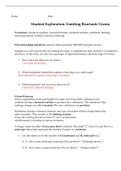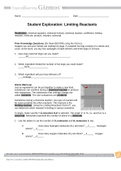Limiting reactants Study guides, Class notes & Summaries
Looking for the best study guides, study notes and summaries about Limiting reactants? On this page you'll find 216 study documents about Limiting reactants.
Page 2 out of 216 results
Sort by
AP Student Exploration: Limiting Reactants Gizmo
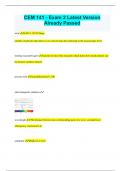
-
CEM 141 - Exam 2 Latest Version Already Passed
- Exam (elaborations) • 14 pages • 2024
- Available in package deal
-
- $9.99
- + learn more
CEM 141 - Exam 2 Latest Version Already Passed mole 6.022 x 10^23 things number of particles that allows us to convert from the molecular to the macroscopic level limiting reactant/reagent amount of one of the reactants which limits how much product can be formed. smallest amount. percent yield actual/theoretical x 100 electromagnetic radiation wavelength The distance between two corresponding parts of a wave. seconds/wave. 1/frequency. measured in m amplitude Height of ...
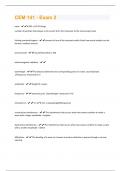
-
CEM 141 - Exam 2 Questions With 100% Correct Answers.
- Exam (elaborations) • 9 pages • 2023
- Available in package deal
-
- $7.99
- + learn more
mole - 6.022 x 10^23 things number of particles that allows us to convert from the molecular to the macroscopic level limiting reactant/reagent - amount of one of the reactants which limits how much product can be formed. smallest amount. percent yield - actual/theoretical x 100 electromagnetic radiation - wavelength - The distance between two corresponding parts of a wave. seconds/wave. 1/frequency. measured in m amplitude - Height of a wave frequency - waves/second. 1/wavelength. mea...
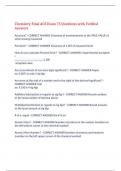
-
Chemistry Final ACS Exam 75 Questions with Verified Answers,100% CORRECT
- Exam (elaborations) • 7 pages • 2024
-
- $11.39
- + learn more
Chemistry Final ACS Exam 75 Questions with Verified Answers Accuracy? - CORRECT ANSWER Closeness of measurements to the TRUE VALUE of what is being measured Precision? - CORRECT ANSWER Closeness of a SET of measurements How do you calculate Percent Error? - CORRECT ANSWER I experimental-accepted I ____________________ x 100 accepted value Are zeros infront of non-zero digis significant? - CORRECT ANSWER Nope! ex: 0.0071 is only 2 sig figs Are zeros at the end of a number and...
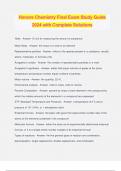
-
Honors Chemistry Final Exam Study Guide 2024 with Complete Solutions
- Exam (elaborations) • 11 pages • 2024
- Available in package deal
-
- $12.49
- + learn more
Honors Chemistry Final Exam Study Guide 2024 with Complete Solutions Mole - Answer- SI unit for measuring the amount of substance; Molar Mass - Answer- the mass of a mole of an element Representative particles - Answer- refers to the species present in a substance: usually atoms, molecules, or formula units Avogadro's number - Answer- the number of representative particles in a mole Avogadro's hypothesis - Answer- states that equal volumes of gases at the same temperature and pressure ...
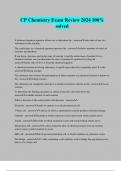
-
CP Chemistry Exam Review 2024 100% solved
- Exam (elaborations) • 16 pages • 2024
-
- $12.49
- + learn more
CP Chemistry Exam Review 2024 100% solved A balanced chemical equation allows one to determine the - answermole ratio of any two substances in the reaction. The coefficients in a chemical equation represent the - answerrelative numbers of moles of reactants and products. If one knows the mass and molar mass of reactant A and the molar mass of product D in a chemical reaction, one can determine the mass of product D produced by using the - answermole ratio of D to A from the chemical equa...
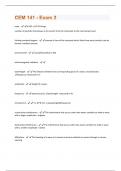
-
CEM 141 - Exam 2 Questions And Answers Rated A+ New Update Assured Satisfaction
- Exam (elaborations) • 8 pages • 2024
- Available in package deal
-
- $7.99
- + learn more
mole - 6.022 x 10^23 things number of particles that allows us to convert from the molecular to the macroscopic level limiting reactant/reagent - amount of one of the reactants which limits how much product can be formed. smallest amount. percent yield - actual/theoretical x 100 electromagnetic radiation - wavelength - The distance between two corresponding parts of a wave. seconds/wave. 1/frequency. measured in m amplitude - Height of a wave frequency - waves/second. 1/wavelength. meas...
GIZMO Limiting Reactants SE(ALL ANSWERS CORRECT)-GRADED A+
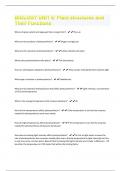
-
BIOLOGY UNIT 6: Plant structures and Their Functions | 96 Questions and Answers(A+ Solution guide)
- Exam (elaborations) • 9 pages • 2023
- Available in package deal
-
- $2.99
- + learn more
Where do green plants and algae get their energy from? - The sun What are the products of photosynthesis? - Oxygen and glucose What are the reactants of photosynthesis? - Carbon dioxide and water Where does photosynthesis take place? - The chloroplasts How are chloroplasts adapted to photosynthesise? -They contain chlorophyll which absorbs light What type of reaction is photosynthesis? - Endothermic What are the potential limiting factors that affect photosynthesis? - Light intensity, conc...
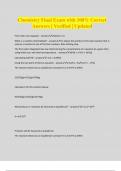
-
Chemistry Final Exam with 100% Correct Answers | Verified | Updated
- Exam (elaborations) • 17 pages • 2024
- Available in package deal
-
- $12.49
- + learn more
Chemistry Final Exam with 100% Correct Answers | Verified | Updated First order rate equation - answerln(Ao/A) = kt What is a reaction intermediate? - answerIt's always the product in the slow reaction that is used as a reactant in one of the fast reactions. Rate limiting step. The first order integrated rate law: Determining the concentration of a reactant at a given time using initial conc and rate by temperature. - answerln[A]t = e^(-kt + ln[A]₀) Calculating half-life - answert 1/2 ...

